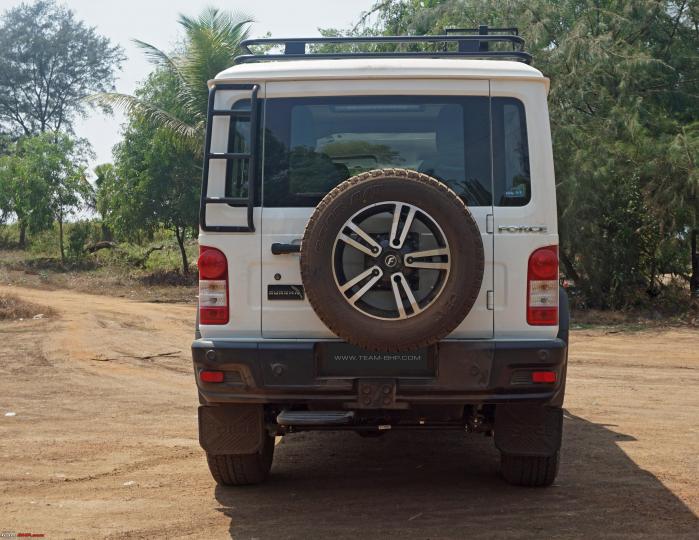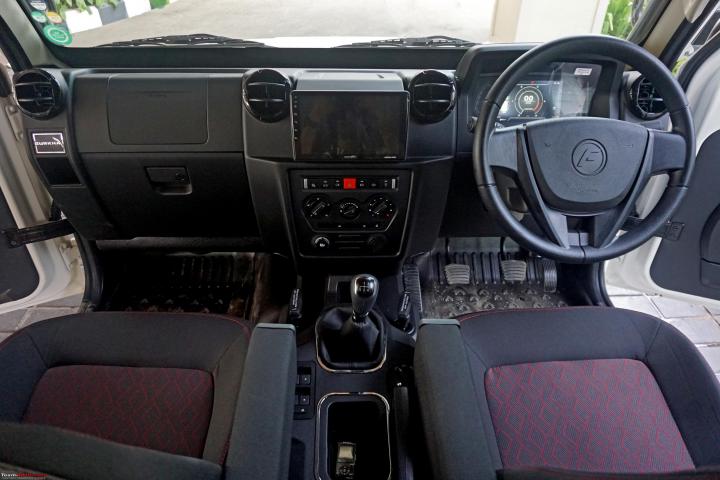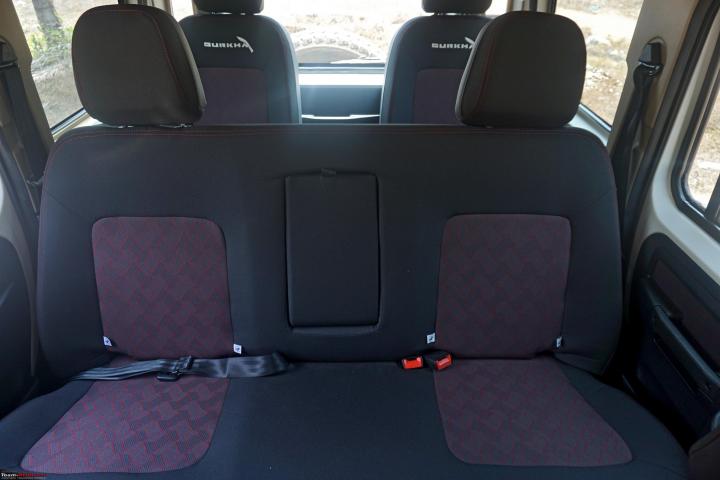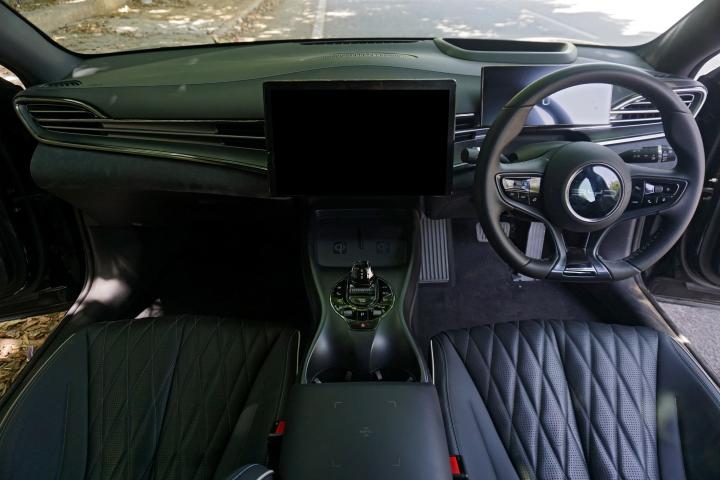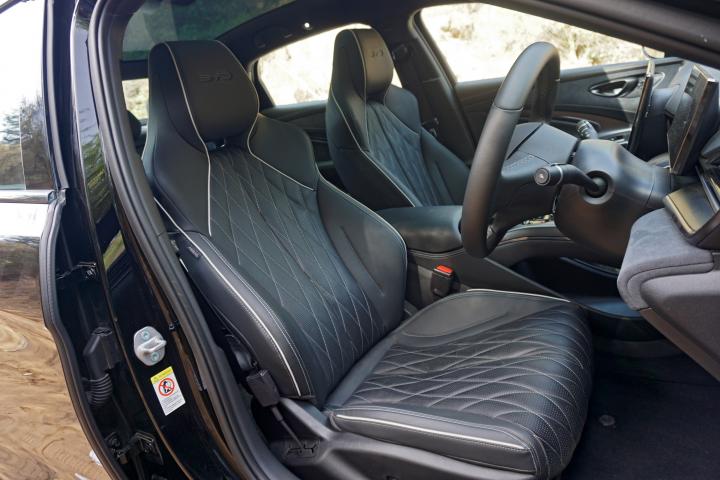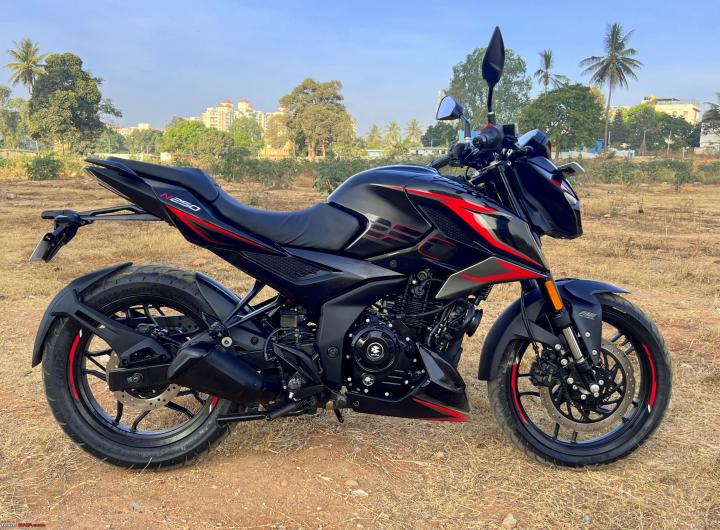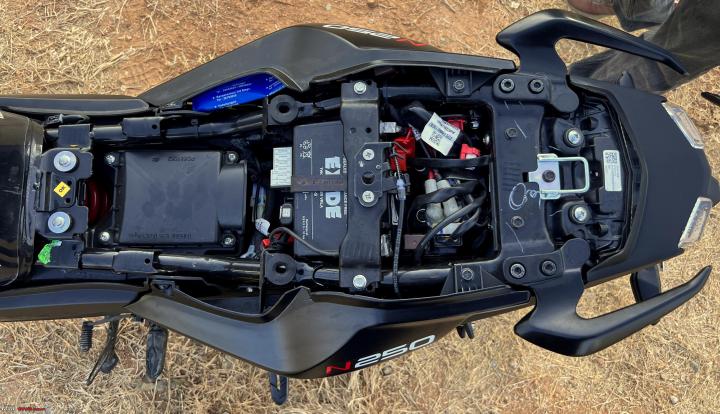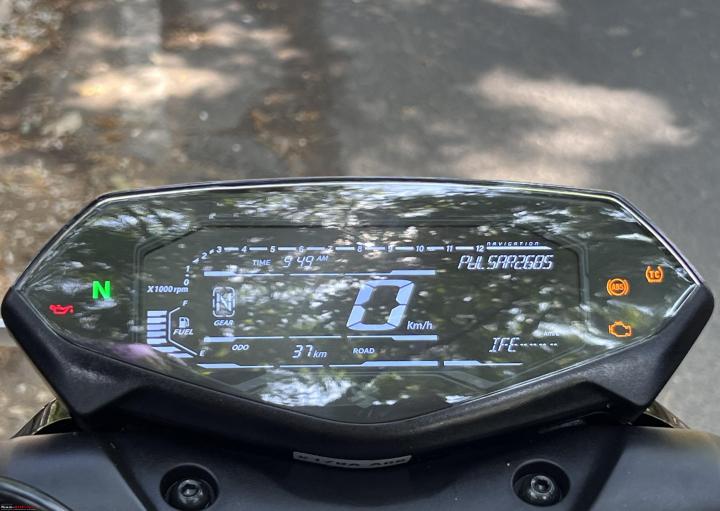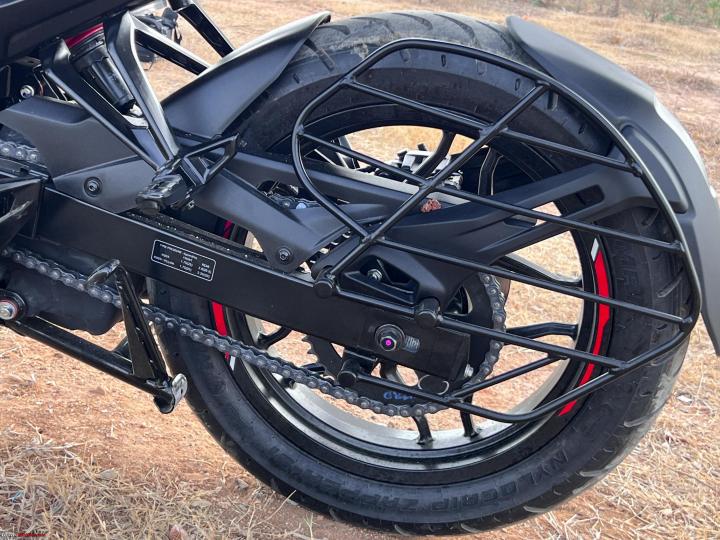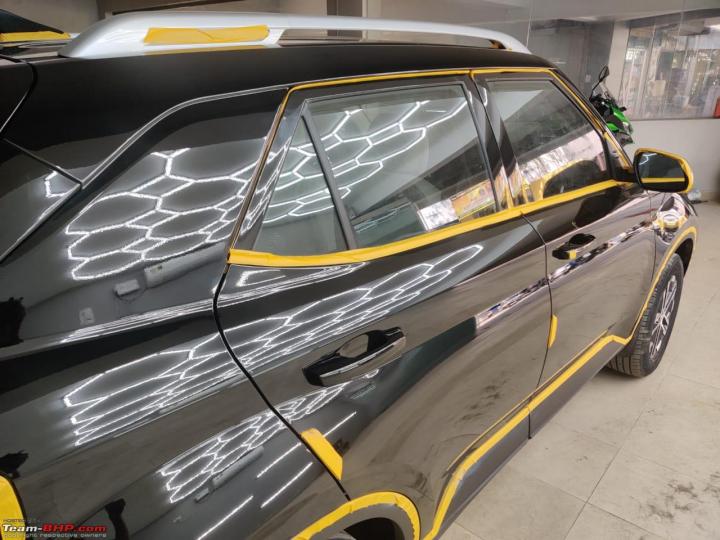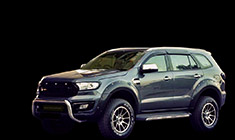News
Our new Maruti Brezza VXi MT: Buying experience and a detailed review
The car is tuned for fuel economy. After driving sedately, I could see a fuel efficiency of 25+ km/l on the MID.
BHPian ashis89 recently shared this with other enthusiasts.
Two months ago, RoadRunner went away and in came a new dude to take its place - Maruti Suzuki Brezza VXI MT. Bigger, stronger, better in every possible way than the outgoing car… or is it?
The yellow-eyed boui!
The Good
- Simple and reliable NA engine which is E20 compliant
- Refined engine with good low-end performance
- Good fuel efficiency
- Light steering and light clutch make it a breeze to drive in the city
- Standard safety features and based on a safe platform
The Bad
- Engine doesn’t rev as cleanly as the predecessor
- Engine runs out of breath fairly quickly along the rev range
- Seats are not comfortable
- Headlight throw is average
- A super boring design in a sea of swanky cars
- Steering doesn’t return to centre post a turn
- Limited suspension travel
And the ugly…
- Cost cutting in the interiors and exteriors is clearly evident
- Uneven fit and finish in many areas
- Criminal act of adding rear seat belt reminders without providing any weight sensors
Requirements and purchase decision
The outgoing car, fondly called as RoadRunner, was a WagonR inching towards its 13th year. In the last few years, it had covered fewer kms but had suffered some bruises and felt its age. My father is the primary user and he loved the WagonR. It was compact, had upright seating and easy to drive. With excellent visibility, it was a breeze to pilot around on narrow busy roads. Being an old car, he didn’t flinch when the car got a few bruises. And it was a Maruti. All the features worked without fail and local Maruti dealer Sky Auto took good care of it. Also, the usage was 1000 kms per annum, maybe 2.
Why change something that ain’t broken?
The car felt its age. The windshield had picked up scratches which caused a lot of glare while driving at night. The interiors rattled on bad roads. The paint had picked up scratches as well. The lack of low-end torque on the K10 engine made the city drive frustrating at times. Fixable issues but spending 50k on a 13-year-old car didn’t make sense. Also, the car felt small at times when we were full house.
- Should have more space than the WagonR yet not too big for daily use
- Should be easy to drive with good visibility all around
- Should have a strong AC to beat the humid climate
- Should have good driveability with good low end torque
- Should have rear camera, parking sensors
- Should be a Maruti and should be a manual (father’s clear requirements but more on that later)
Then why not another used car?
It had to be a new car. My father’s first car was a used 2-year-old M800 (back then needed a car immediately without a waiting period) which stayed with us for 11 years. The second car was the used 2-year-old WagonR (saw a good deal and I bought my first car) which stayed with us for another 10+ years. This time I wanted a new car for him. One should experience the feel of a new car at least once in life. This had to be it.
Contenders:
- Baleno/Swift: My father was impressed by the Baleno as it was a popular model, spacious and looked good. But I have spent considerable time with this model and I suggested the Swift instead. Same engine, upright seating and better visibility. He agreed.
- Dzire: After agreeing on Swift, he said he should get a DZire instead which is a slightly bigger and a sedan. But it is old and from a dying segment. His current office ride is a WagonR or a yellow plate Dzire and too common on our roads. And he also experienced that the new Dzire is not comfortable on longer trips.
- Jimny: Some time last year when Maruti announced discounts on the Jimny, I pitched the idea to him on a Sunday afternoon – how about getting a Jimny? He never heard of the model and was curious. So I sent him a few pictures of the Jimny. Minutes later he calls me back and says that the Jimny was a Maruti Bolero. A Bolero SLX was his ride for many years when he was in service. He can’t drive such a car as his personal ride. End of discussion.
- Brezza: A few months ago, I drove a Zoomcar Urban Cruiser on a 600 km trip, on good and bad roads. I have also driven the S-Cross petrol for 2000+ kms as well as TDed the Ciaz petrol which has the previous K15 series engine. I knew the engine was perfect for city use and managed to do the job on the highway. And the Brezza felt like a bigger and more comfortable WagonR which addressed all its shortcomings. My father was surprised to know the Brezza was marginally costlier than a Dzire. His thought was that the car was successful in the market, sold/serviced by Maruti, looked good, was reasonably priced and hence, a good choice.
- Grand Vitara was another option but it would be big for a small city use. Given the use case of 1-2 people using it within the city on most occasions, GV would be an overkill. Some suggested to check out the Fronx as it was the new SUV on the block but I could never digest its looks. The smaller engine was another factor so we never checked the car in the first place.
Other brands didn’t stand a chance as it had to be a Maruti after all.
So Brezza was finalized. Father wanted me to book the car but I forced him to take a test drive first. And yes, only Brezza was test-driven, rest were struck off on paper.
Variant and color
This was easy to decide. White was dull, red and blue were too loud, khaki was an oddball, black was unavailable in the lower variants. Between grey and silver, the latter was preferred by all of us unanimously.
Among the variants, I chose the VXI as it had all the essential features that we were looking for and then some more. ABS, airbags, ESP, rear head-rests, rear AC vents and an Android Auto-equipped head unit were important. Hill Hold Assist, automatic climate control, power-folding mirror and steering-mounted audio controls were bonus features.
Test Drive Experience
Checked online for the nearby dealers and booked a home TD visit. A week went by and nothing happened. Then reached out to a few contacts in a local dealership, Sky Automobiles and asked to get me a test drive. That did the trick and I got a call from the sales team asking when they can come for TD. Any morning worked for my father and me but they should call in advance and come. So they offered to come the very next day and also confirmed that we were looking for a manual car.
Next day they arrive in a red dual-tone Brezza ZXI+ AT. I wasn’t sure how else could I have been more clear about needing a manual car. Nevertheless, we went for a short drive. Asked the driver and SA to drive while I and my parents got on the rear bench. It was a squeeze but doable. Leg space worked for us and the rear AC vent too. Next, I asked them to get us a manual car only.
Next day, the team got a manual Brezza ZXI+ in the same dual-tone shade. I did a TD for 0.2 km (not a typo) and got my answers. Then I handed over the car to my father and asked him to go on a longish TD with the driver. Meanwhile, me and the SA walked back the 200 meters to discuss about exchange offer and price.
Booking and delivery
The SA from Sky was a very nice guy. Brezza was one of the rare models not running any discounts but he mentioned he would try for the best deal possible since he knew I came from a reference. They also had the car readily available in stock. If I booked today, they could deliver it in 2-3 days.
On the other hand, my father found some contacts at another MS dealer, Jyote Motors. Jyote promised my father to match and better the deal that we already had from Sky. So finally, I paid the token 11k and booked the car on Jan 20 2024, with Jyote - a Splendid Silver Brezza VXI MT. Delivery was promised within Jan and we were in no hurry. I also explained the situation to the Sky team and thanked them for their diligence.
No hurry is fine but I wanted to know a tentative date when the car would be available. We were in February and Jyote only had one thing to say always – disruption at the MS plant and hence, dispatch was delayed and he would confirm in 2 days. Those 2 days never came after a few follow-ups. My father was irked as well. I spoke to a friend who confirmed there are no issues with Brezza dispatch.
I didn’t like this opaque, unethical approach. So on Feb 15 2024, I called up the Sky team and asked if a silver Brezza was still available with them. That piece was already sold but they were ready to place an order immediately and get it dispatched from the factory in the current lot. Promptly paid the booking amount and booked the same variant with Sky. Over the next few days, I was apprised of the status of the car's arrival. The SA came and collected the cheque from home.
On Feb 22 2024, the new car was delivered at my parent’s place after being duly registered, HSRP and basic accessories fitted. All this, within 7 days and everything was done from home. We got some cash discounts, accessories and better exchange price for the RoadRunner. They got a cake for my parents to celebrate the new car. Then they took away the old car on the same day after delivering the new one. Overall, the experience with Sky was very good. Their service team had been maintaining the outgoing WagonR for several years now and we should have stuck with them in the first place.
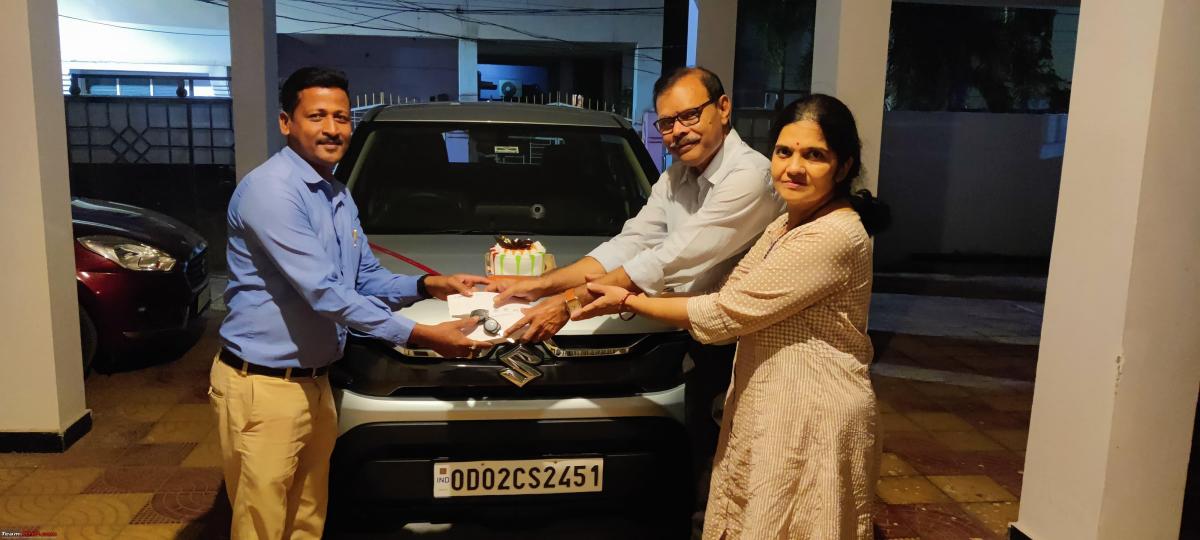
Meanwhile, I cancelled the booking with Jyote and the amount was credited 1.5 months later after following up once.
Engine and performance
This variant comes with a K15C 1.5L petrol engine which is E20 compliant. It doesn't have the Smart Hybrid setup. Press the clutch and then, you can crank the engine. When cold, the engine is audible but smooth. When warmed up, the note is barely audible at low revs. I haven't pushed it much yet but the engine wasn't 'loud' at higher rpms.
The engine is tuned for low-end response and that manifests in city drive. Slot into 1st(or even 2nd) and release the clutch, the car moves away smoothly. Just like a diesel, this petrol car can climb mall slopes with little or no accelerator input. Our apartment has a rather steep ramp up from a narrow road which requires a sharp 90-degree turn and climb. This car climbs without any A input and no momentum.
In the city, the short gearing means the car doesn’t ask for downshifts. I could potter around at 20 kmph in the 3rd/4th gear or 40 kmph in 5th gear. Out on the highway, the car is quick until 80-90 kmph before the power starts tapering off. Just like the WagonR, it can do 100 kmph@3000 rpm. Short gearing means the car feels quick in the city traffic. Keep the RPM below 2.5k, the car remains peppy but very silent. For my father, this is an upgrade from the WagonR which was lethargic at times and also bogged down by the AC running at all times.
The clutch is super light. I covered 100+ kms on multiple days in city/highway conditions and never had a reason to complain. The gearshift is acceptable with a hint of resistance at times. That 6th is always missed on the highway.
Engine bay doesn't have any paint
Air intake is at the front
Bonnet has insulation
The underbody guard barely extends 1 feet beyond the radiator
Fuel economy
The engine is tuned for fuel economy and that shows in the performance but also while visiting the fuel bunk. This variant doesn’t come with any hybrid assist. Drive sedately and I could see 25+ kmpl on the MID. After driving for 500 kms (70% city/30% highway, 100% AC with idling time), the MID was showing 17.4 kmpl. T2T numbers were 15.8 kmpl. That's a usable range of 500 kms at least. This could improve as the engine opens up further but for a 1.5L NA petrol, I was expecting much less.
Suspension
It is a soft pliant suspension which is good for the city. Sharp bumps are felt with a jolt but smaller ones are masked well in silence. Out on the highway, the body roll can be felt and so do the vertical movements, due to the soft suspension. I felt less comfortable driving this aggressively than my Seltos.
The rear suspension travel is sub-par. In axle-bender situations, the rear tyre can lift up easily. Our parking is the first one next to the boundary wall while the parking space itself is 3ft above the road. While taking the car out, one has to take a sharp right turn onto the gradual ramp down to the road. The Brezza almost invariably lifts its rear left wheel while taking the turn whereas my Seltos never did so.
The underbody is clean without any protrusions and the ground clearance is better than the Seltos. That said, the small plastic underbody guard is barely of any help.
Steering and brakes
Steering is feather light and good for city use and a boon at parking speeds. But the steering lacks feedback and feels lifeless on the highway. It doesn’t return to centre post a turn and that’s another drawback. I was expecting the car to have a tight turning radius given the smaller footprint but I find it no better than my longer and wider Seltos.
It has the new trending flat-bottom steering
ESP button is available to the right of the steering wheel. Aftermarket fog lamp and headlight leveller buttons are also seen in the pic
Brakes are progressive and provide good feedback. Unlike the Koreans, the ABS is well-calibrated. Tyres are wide 215/60 R16 MRF Wanderer Ecotred. This is probably the only Maruti where the company provides the same size of tyres from the base till the top model. Spare wheel is also of the same make and size, fitted on steel wheels like the other 4 tyres. The MRFs are loud on the highway.
Car comes with a dead pedal which I am used to knowing and find comfortable
Continue reading ashis89's review for BHPian comments, insights and more information.
News
Force Gurkha 5-Door : Observations after a day of driving
The Gurkha gets an independent double wishbone suspension with coil springs at the front and a multilink suspension with a Panhard rod and coil springs at the rear. It now rides on 18-inch wheels with 255/65 section tyres. The low-speed ride quality is good for a ladder-on-frame off-roader.
Driving the 2.6L Diesel 5-speed MT
2,596cc, 4-cylinder diesel engine puts out 138 BHP & 320 Nm:

The 2024 Gurkha retains the same 2.6-liter, 4-cylinder diesel engine as the outgoing car. However, the unit has been retuned to deliver more power and torque. It now develops 138 BHP @ 3,200 rpm and 320 Nm @ 1,400-2,600 rpm. These figures are considerably higher than the 90 BHP & 250 Nm of the outgoing car. But even with the additional power, the Gurkha does not feel sporty to drive on the road.
To fire up the engine, you do not need to press the clutch anymore. On start-up, there is some body shake, and at idle, vibrations are felt on the steering wheel, pedals, handbrake, and seats.
Release the clutch gradually and the car moves forward without any throttle input. You can even pull away from a standstill in 2nd, albeit with some extra throttle input. Throttle response is satisfactory and power comes in smoothly. Low-speed drivability is fair and in the lower gears, the car can pull reasonably well at anything over 1,000 rpm. The engine starts feeling comfortable above ~1,250 rpm. Keeping up with the city traffic is not difficult, but if you need to close a gap, a downshift might be required.
On the open road, the Gurkha is a little quicker than before thanks to its higher power and torque output. However, it still isn't what we would call fast or even brisk. Due to its heavy kerb weight, the 5-door takes its own sweet time to accelerate. On the roads of Goa, I managed to get it past 80 km/h on a few occasions, but only just. The lighter 3-door feels slightly quicker. Still, it's not fast by any means. Something like the Mahindra Thar will leave the Gurkha in its dust. Overtaking slower vehicles on undivided highways will require some planning and aggressive downshifting. The turbo kicks in ~2,000 rpm and pulls nicely till 3,000 rpm. When pushed, the engine revs to 3,500 rpm. This is very low and you might need to upshift in the middle of overtaking manoeuvres. The Gurkha is more suited to a sedate driving style. It can cruise at 80 km/h in 5th gear with the tachometer reading ~1,750 rpm.
The clutch is light with a pedal travel that's neither too long, nor too short. The transmission has been changed. The outgoing vehicle's gearbox could handle just 250 Nm of torque. With the torque increased to 320 Nm, Force Motors had to use the 5-speed MT of the erstwhile Gurkha Xtreme. This gearbox has long throws and a notchy shift action. It's not suitable for snappy shifting. There is also a clicking noise heard every time you move to neutral from any gear.
The Gurkha also gets a drive mode selector. While Power is the default mode, one can select the Eco mode by pressing a button on the centre fascia. In Eco mode, the throttle response is dumbed down and the car feels very sluggish. While it is alright to use Eco mode in the city in slow-moving traffic, if you want to close a gap to the car in front quickly, you will need to shift to Power mode. Eco mode is not suitable for highway driving at all.
Apart from the drive mode selector, the Gurkha gets an idling start/stop function to improve fuel efficiency. This feature worked seamlessly on our short test drive and was not intrusive. It can be turned off by pressing a button on the centre fascia.
Coming to NVH, the engine can be heard inside the cabin at all times. It is louder as you accelerate. Above 3,000 rpm, the engine starts screaming and begging for an upshift. Wind noise is not heard at 80 km/h, but tyre noise is present at even 60 km/h. There is a prominent body shake on start-up and shutdown. As mentioned earlier, vibrations can be felt on the steering wheel, seat, and pedals at idle. The gear lever moves as you accelerate as well.
Lots of insulation under the bonnet:
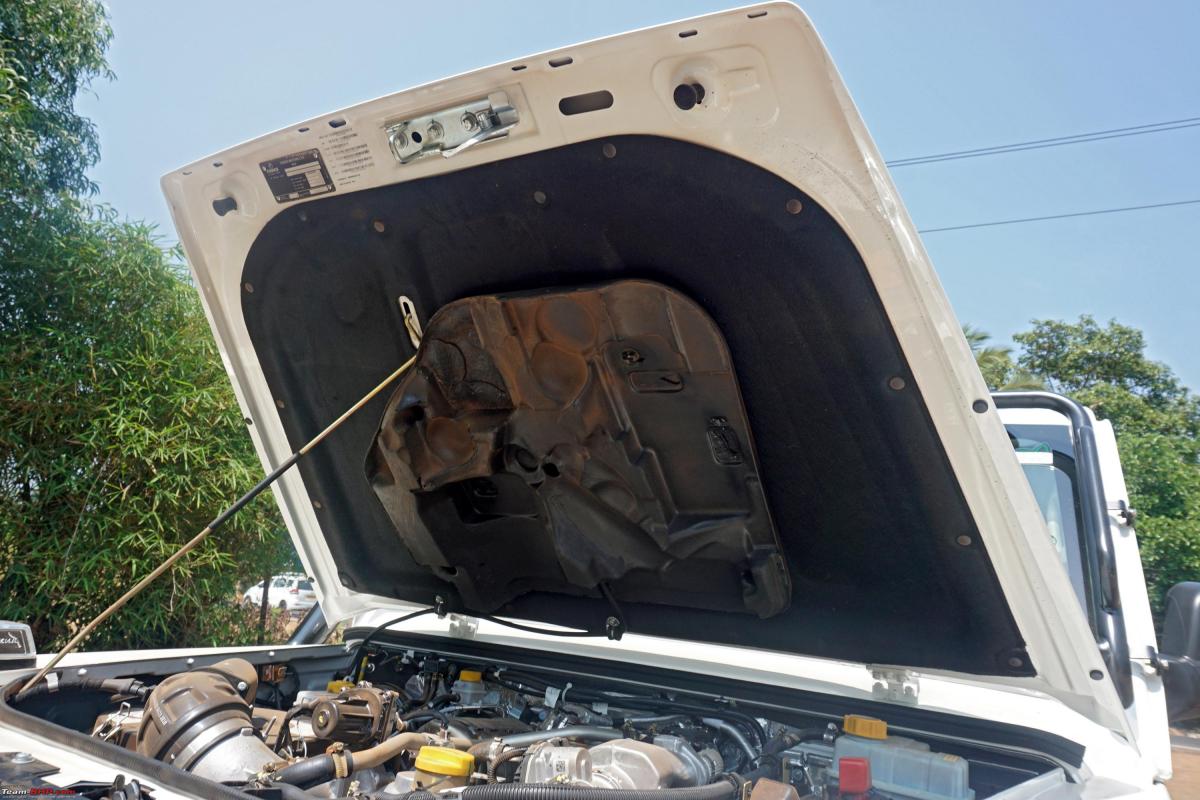
Suspension

Ride Comfort
The Gurkha gets an independent double wishbone suspension with coil springs at the front and a multilink suspension with a Panhard rod and coil springs at the rear. It now rides on 18-inch wheels with 255/65 section tyres. The low-speed ride quality is good for a ladder-on-frame off-roader. The independent suspension is very competent while handling small to medium-sized potholes and bumps. There is of course some side-to-side movement in the cabin, yet in comparison with some of the other off-roaders, the Gurkha was impressive.
Handling & Dynamics
High-speed stability is acceptable. The maximum speed that we could achieve on the roads of Goa was just a little over 80 km/h. The Gurkha didn’t feel nervous at any point.
However, going around corners is a different ballgame. The Gurkha is a tall vehicle and there is a lot of body roll. Do remember that this is an off-roader and not very good at cornering. In the interest of safety, I did not push the car hard through the country roads with multiple blind corners. Anyway, it's not a car that likes to be driven fast.
Steering
The hydraulic power steering is not as light as the electric units in modern cars at parking or crawling speeds. Those who are used to modern EPS systems will inevitably complain. Once the speedometer needle climbs, the steering does feel easier to operate. It also offers sufficient weight on the highway.
Braking
This Gurkha comes with the ubiquitous front disc & rear drum braking hardware. The brakes are equipped with ABS + EBD. We feel that the brakes bite too late. The pedal travel is long and even after the brakes bite, they are not strong. They certainly do not inspire confidence.
Niggles & Problems
While the Gurkha has largely remained the same, Force has added some more electronics to it. And the chances of things going wrong with new electronics are generally high. On one of the test cars, the reversing camera kept getting engaged and the navigation on our test car wasn't working. From experience, I can say that shift-on-the-fly systems are not as robust as manual transfer cases. We highly recommend that you do a thorough PDI and make sure that your car is free of any niggles or issues.
Continue reading the discussion on the Force Gurkha 5-Door on our forum.
- Tags:
- Indian
- Force Gurkha
- Gurkha
- Review
News
2024 Force Gurkha 5-Door Review : 9 Pros & 9 Cons
Force Motors has worked on some of the shortcomings of the Gurkha and launched an updated version. Now, the off-roader gets a 5-door version (apart from the 3-door) with 3 more seats.
Force Gurkha Pros
- Macho styling & incredible street presence. Robust build too
- Far more user-friendly than the old Gurkha due to superior interiors & better amenities
- Shift-on-the-fly 4x4 with low range, diff locks, satisfactory all-round visibility & 233 mm GC. Excellent gradability, approach, departure & break-over angles make it a potent off-roader
- Choice of 3-door and 5-door (7-seater) versions gives it an edge over competing off-roaders
- Rides noticeably better than other purpose-built off-roaders in the market (especially the Thar)
- 5.5 m turning radius (3-door) is not as wide as its competitors
- Homologated accessories mean no cop trouble for owners ([i]windscreen protection bar, roof carrier, ladder, headlamp & fender lamp grilles etc.[/i]). Snorkel is factory-fitted!
- 500L boot space (3-door) is enough for a family's vacation luggage
- Features such as the hard top, LED headlamps with DRLs, rear wash & wipe, 9-inch touchscreen HU, power & eco drive modes, TPMS, dead pedal, rear A/C vents...
Force Gurkha Cons
- High floor makes ingress & egress very difficult for the elderly in particular
- Braking capability is below average. Pedal travel is long too
- No soft-top or convertible options like the Thar. No Petrol engine or Automatic transmission either
- Tall stature equates to lots of body roll and poor handling
- Despite the increased power & torque, the Gurkha's outright performance is mediocre
- Overall fit & finish, quality of interior plastics, ICE audio, camera display…
- Notchy 5-speed MT has long throws and is cumbersome to use
- Missing features such as 6 airbags, ESP, hill-hold / descent control, sunroof, auto headlamps, auto wipers, driver's seat height & lumbar adjustment, auto-dimming IRVM, electrically folding ORVMs etc.
- 5-door variant's 3rd-row captain seats cannot be folded or flipped. You'll need to place your luggage on & around them (or get a carrier)
Read Team-BHP's detailed 2024 Force Gurkha 5-Door Review.
- Tags:
- Indian
- Force Gurkha
- Gurkha
- Review
News
2024 BYD Seal : Our observations after a day of driving
In a straight line, the BYD Seal feels stable. It doesn’t feel nervous and maintains its composure at high speeds.
Driving the BYD Seal Premium
Powering the BYD Seal Premium is a Permanent Magnet Synchronous Motor that puts out 308 BHP and 360 Nm torque:
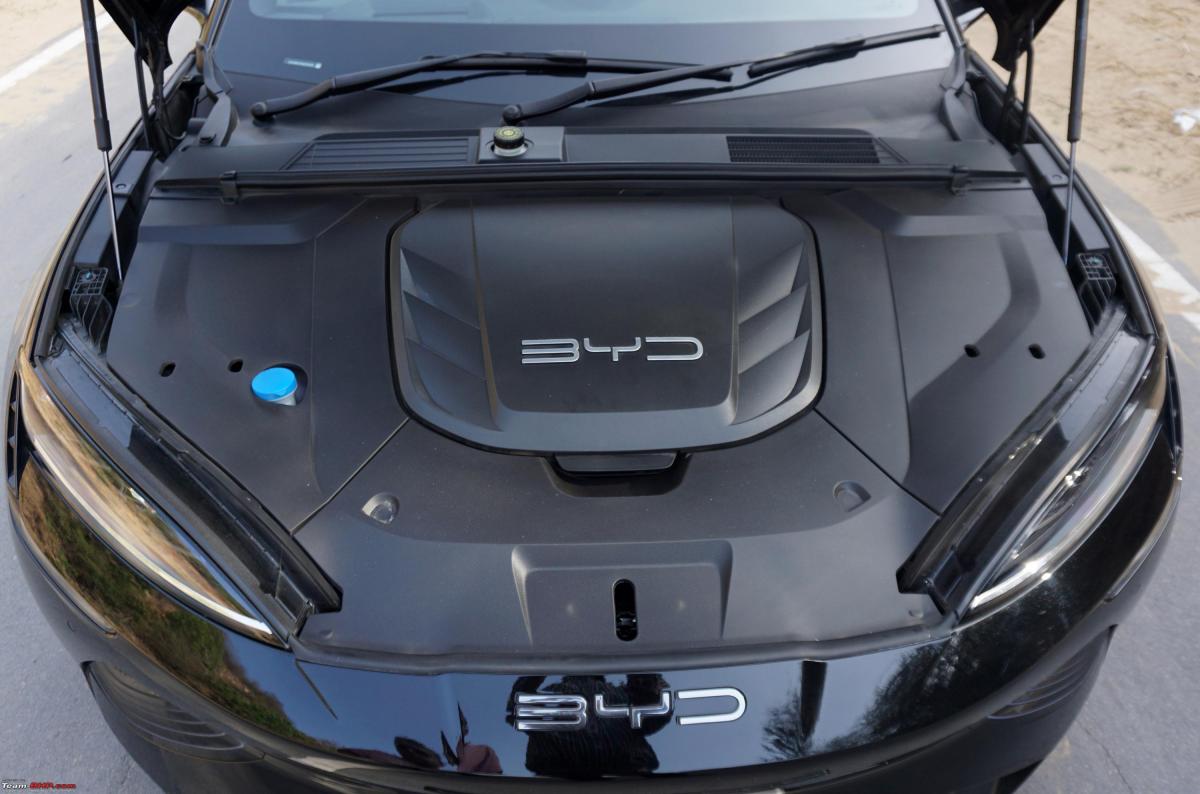
The Seal is built on BYD's e-Platform 3.0 which is EV-specific and is not based on an IC engine platform like most EVs available in India. Hence, the design of the batteries and powertrain has been done keeping the EV-specific requirements in mind. This platform comes with cell-to-body technology which integrates the battery and the vehicle body floor together making the battery's sandwich structure evolve into a sandwich structure for the complete vehicle. The battery pack is sealed as part of the body using an integrated sealing plate design, which BYD claims, increases the rigidity of the floor by 13 times. BYD claims that the Blade battery has passed the nail penetration test and an extreme strength test that saw a 46-tonne truck driving over it. The Blade battery has a claimed driving mileage of more than 5,00,000 km.
We got to drive the Premium variant of the Seal which comes with an 82.56 kWh battery, rear-wheel drive and an electric motor that develops 308 BHP and 360 Nm. With your foot on the brake pedal, hit the Start/Stop button to bring the electric motor to life. Shift to ‘D’ mode, take your foot off the brake pedal and the car gets off the line in the smoothest way possible. There is faint music that is played on the outside of the car while driving around at low speeds. It’s to let the pedestrians know that there’s a car coming. Build some speed and the music stops.
If you primarily drive around in the city, you will appreciate the Seal’s smoothness. The power delivery till part throttle is linear and predictable. No jerks from gearshifts and no engine sound means it is an extremely refined experience. Floor the A pedal and you will be greeted with instant acceleration. Performance is brisk with power available right from the get-go. BYD claims a 0-100 km/h time of 5.9 seconds, which is believable. You’ll definitely be ahead of most of the IC engine cars when the signal turns green. If you enjoy instant acceleration and are experiencing an electric car for the first time, this car might just make you a convert. If you’ve driven some of the other EVs, you will notice that the acceleration is very similar to others in this range.
Out on the highways, the Seal is just as good as in the city. Getting up to triple-digit speeds and maintaining them is effortless. Want to make a quick overtake, no worries there. Just bury the accelerator pedal and you will zoom past the car ahead with ease. You'll hit silly speeds effortlessly and not even realize it due to the lack of drama (engine noise, etc.). However, if you drive hard, the range will drop faster. This is also why you will see EVs that are driving longer distances sticking to the middle lane and cruising at 80-100 km/h (which is the best cruising speed for the current lots of EVs).
There are 3 driving modes to choose from and unlike some other cars, these aren't gimmicky. They're mapped specifically for different driving styles and also change the steering weight.
- Normal Mode: This is the default mode to drive in and works well in the city as well as on the highway. It is a good balance of power and economy. The steering is light in this driving mode.
- Eco Mode: When you want to extract maximum range, this is the mode to engage. The throttle response is dumbed down which results in a smoother drive. However, you never feel that the car is lacking power. There’s still enough power on tap to keep up with the traffic and make those quick overtakes. We found this mode to be the best for driving in the city. The difference in steering weight from normal mode is very little. It almost makes the Normal mode redundant.
- Sport Mode: The throttle response is sharpened, but power is still delivered linearly. It doesn't feel jerky for day-to-day city driving like some other EVs. Push hard and it provides tremendous acceleration but it is not as brutal as the Mercedes AMG EQS 53 or the Volvo C40 Recharge for that matter. One thing to note is that driving in Sport mode eats up battery faster. So it's best to use this mode on the highways when you want to have some fun while driving. The steering is firmed up in this mode. The brakes feel a little sharper too.
Insulation sheet under the bonnet:
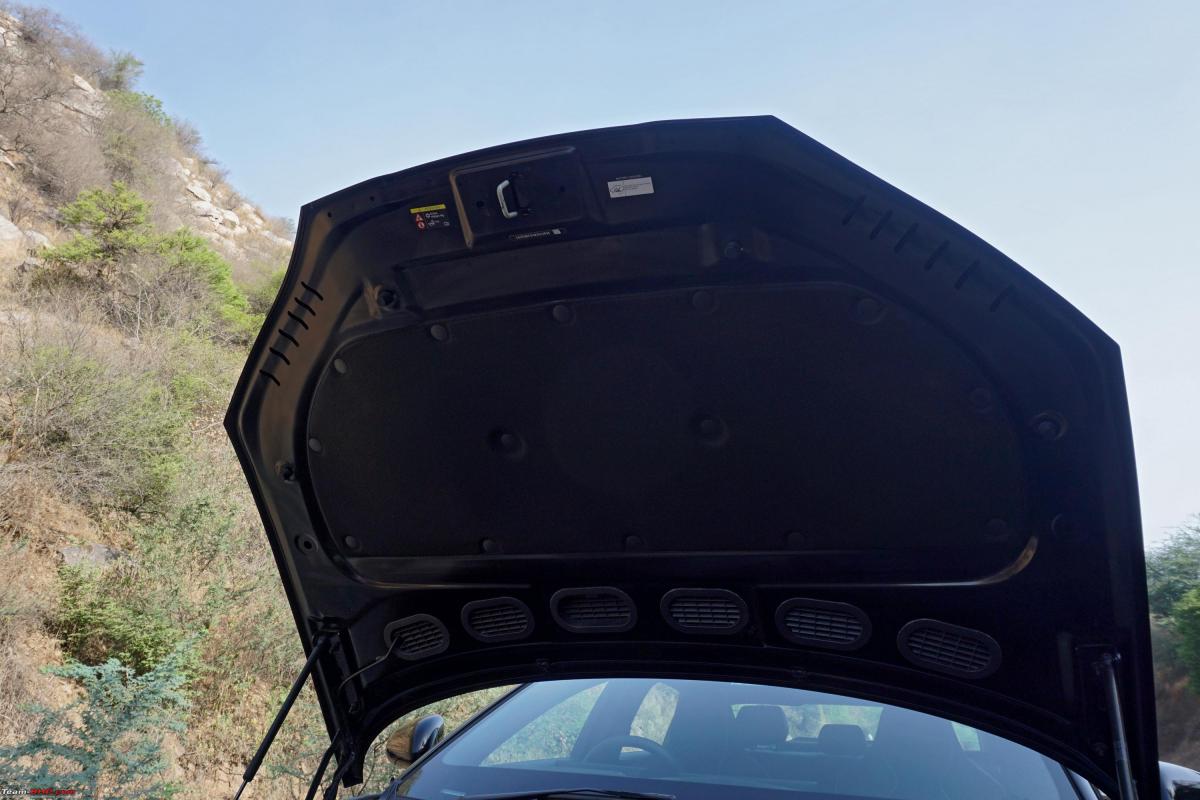
Regenerative Braking
BYD has kept it simple with regenerative braking. There are only 2 levels – Standard and High. The Standard level is barely noticeable and if you have the car in this mode, you might end up using the brakes a lot. The High level very much resembles engine braking in IC engine cars. It’s not very intrusive and you won’t be getting a head nod every time you lift off the accelerator. It’s great for driving around in the city as well as on the highways. People wishing to do hypermiling with the Seal will wish for stronger regeneration from the motor.
Noise, Vibration & Harshness (NVH)
As is the case with EVs, the Seal is also super quiet. There’s no engine or gearbox to make any noise, so the overall driving experience is silent. The windshield and front windows feature soundproof double-glazed glass making the car cabin extremely quiet.
At highway speeds, the wind noise is well controlled and the tyre noise is par for the course. The motor spins silently at high speeds and the whine is very well controlled.
Range
The BYD Seal Premium has a claimed range of 650 km as per NEDC (New European Driving Cycle). Given the rising demand for EVs, there are plenty of charging stations popping up everywhere, which ought to take care of range anxiety as well. There are many apps and websites like pulseenergy.io, plugshare.com, etc. that list out all the charging stations near you. At the end of the day though, remember the golden rule = EVs are best charged where they are parked (either at your office or home).
Charging
When you buy a BYD Seal, you get a 7 kW home charger. The charging time with AC Charging port – Type 2 (7 kW) from 0% to 100% is 12-16 hours. The charging time with a DC charging port - CCS 2 (110 kW/150 kW) from 0% to 80% is 45 minutes. BYD claims that 15 minutes of charging a 150 kW charger adds up to 200 km of driving range. You also get a 3kW portable charger that can be plugged into any 15 Amp socket (the larger 3-pin sockets used for ACs and fridges), but that would take a very long time to charge from 0-100%. If you ever run out of battery, you can always contact BYD’s roadside assistance. You get 6 years of roadside assistance with the Seal.
Suspension

Ride Comfort
The Seal gets a double wishbone suspension at the front and multi-link suspension at the rear. The car rides on 19-inch wheels shod with 235/45 section tyres. Low-speed ride is firm and most cracks and bumps on the road are felt. While the ride is not uncomfortable, it is far from plush. What's nice is that the suspension works silently. Big potholes do register themselves inside and you will have to be careful while tackling them. The recommended tyre pressure is a rather high 42 psi and at this pressure, you do feel a lot of the road. Dropping the pressure while driving in the city might make the ride more comfortable.
Handling & Dynamics
In a straight line, the Seal feels stable. It doesn’t feel nervous and maintains its composure at high speeds. Going over some undulations or expansion joints will result in a fair bit of vertical movement though.
Coming to handling, the turn-in is good but not very eager - very Mercedes-like. The car has a 50:50 weight distribution (over front & rear axles). Body roll is controlled and the car feels fluid and composed on winding roads although not very tactile compared to say, a BMW.
Steering
The electric power steering is a nice unit and easy to operate as well. It is very light at city speeds which makes it very user-friendly. The steering weighs up fairly well on the highways. It is accurate, but relays little feedback.
Braking
The Seal Premium has ventilated and drilled discs at the front and ventilated discs at the rear. All in all, the car has good stopping power and emergency braking situations are handled well too. On the other hand, the brake pedal lacks feel and takes some time to get used to.
Continue reading the discussion on the BYD Seal on our forum.
News
BYD Seal Review : 12 Pros & 10 Cons
The BYD Seal is loaded with safety features like 9 airbags, a 360-degree camera, TPMS, traction control system, ABS + EBD, electronic stability program, hill decent control, hill-hold assist, electronic parking brake with auto hold, adaptive cruise control and ISOFIX child seat anchors for 3 seats, high beam assist and level 2 ADAS features such as automatic emergency braking, adaptive cruise control, blind spot detection, lane departure warning, lane departure prevention, rear cross-traffic brake and more.
BYD Seal Pros
- Good build quality coupled with very appealing styling
- Punchy motor offers fast performance. RWD variant's 0-100 km/h time of 5.9 seconds is enjoyable; AWD variant's performance is ballistic (0-100 in 3.8 seconds)
- Good high-speed stability coupled with sorted handling
- Spacious and well-built cabin with comfortable seats
- Useable 400-litre boot, along with a 50-litre frunk (in the front)
- Inherent EV advantages such as a green image, zero tailpipe emissions, low running costs (charge at home) & top-notch NVH
- We find the BYD Seal to be well-priced for what it offers
- Selectable regenerative braking and drive modes allow you to extract maximum performance or efficiency, as needed
- Sufficient driving range (approx 500 km) for urban commuting as well as the usual road-tripping with family
- 6-year/150,000 km warranty on the car, 8-year battery & motor warranty, 6-year roadside assistance
- Features such as the vehicle-to-load function, soundproof glass, rotating 15.6-inch touchscreen, climate control with heat pump, panoramic sunroof, adaptive cruise control, electrically adjustable A/C vents, NFC key card, etc.
- 5-star NCAP rating, top-notch safety kit & level 2 ADAS to keep you safe
BYD Seal Cons
- 145 mm ground clearance requires you to drive with care over large speed breakers & broken roads
- Firm low speed ride. Liveable, but not plush in the city. You feel bad roads
- Low slung body makes ingress & egress a challenge for the not-so-flexible and elderly
- No option of a lighter-coloured interior theme (cabin is full-black)
- Rear seat offers poor under-thigh support
- Most functions and settings are controlled through the touchscreen, which makes them difficult to access on the move
- Vertical movement over road joints can get annoying
- Missing features such as connected car tech, a spare wheel (in India!!!), wireless Apple CarPlay, etc.
- Poor rearward visibility due to the acutely-angled rear windscreen and large rear headrests
- BYD's currently small dealership & service network. Even major cities like Mumbai & Delhi have just 1 dealer
Read Team-BHP's detailed BYD Seal Review.
News
Bajaj Pulsar N250 : Our observations after a day of riding
The Bajaj Pulsar N250 is a wonderful sport commuter package for the biker who wants a machine which can offer both practicality and fun. The N250 is happiest dealing with a mix of city and highway usage say in the ratio of 80-20.
Riding the Bajaj Pulsar N250

The Pulsar N250 is powered by an air & oil-cooled 249cc single-cylinder engine putting out 24.2 BHP @ 8,750 rpm and 21.5 Nm @ 6,500 rpm. The compression ratio is a relaxed 10.3:1.
The 2-valve engine has fantastic low-end and mid-range usability in the urban environment. First gear is short, while second is relatively tall. However, this doesn't affect acceleration from low speeds thanks to the brilliant low-end tractability of the engine. Third and fourth gears are short, while fifth gear is configured relatively tall to cater to highway cruising. A sixth gear is missed sorely as it could have aided highway cruising at lower revs.
The engine tends to run out of steam at higher revs in general, but by and large, the N250 can take on even highway duty with ease and easily hold good speeds all day long thanks to the excellent refinement levels of the engine. For comparison, I also ride a Yamaha FZ25 for city commuting, and I can say for sure that the Pulsar N250's refinement levels are a notch higher than even the FZ25's over a wide range of rpms.
The clutch is super-light and is extremely easy to use, aiding those frequent moments when one has to navigate through traffic jams in city rush hour commutes. The gear lever is very nice to use; The shifts are precise and slick, requiring minimal effort and it is very easy to find neutral.
Refinement & NVH
Refinement levels for this bike are best-in-class, and I say this after riding bikes such as the Yamaha FZ25, TVS Apache RTR 200 and the Suzuki Gixxer 250. The exhaust note has a deep bass undertone to it, which continues throughout the lower and mid-range of the rpm spectrum. Acceleration is very smooth and cruising at any speed under say 100 km/h is very refined. Bajaj claims to have added an offset crank and a counter-balancer to keep vibrations at bay.
NVH levels are very low and the N250 feels like a well-put-together bike for the most part. What remains to be seen is how this bike ages. Bajaj bikes and Pulsars in general don't have a good reputation when it comes to retaining refinement levels as they age. We hope Bajaj has taken steps to improve the N250 in this regard.
Suspension & Handling
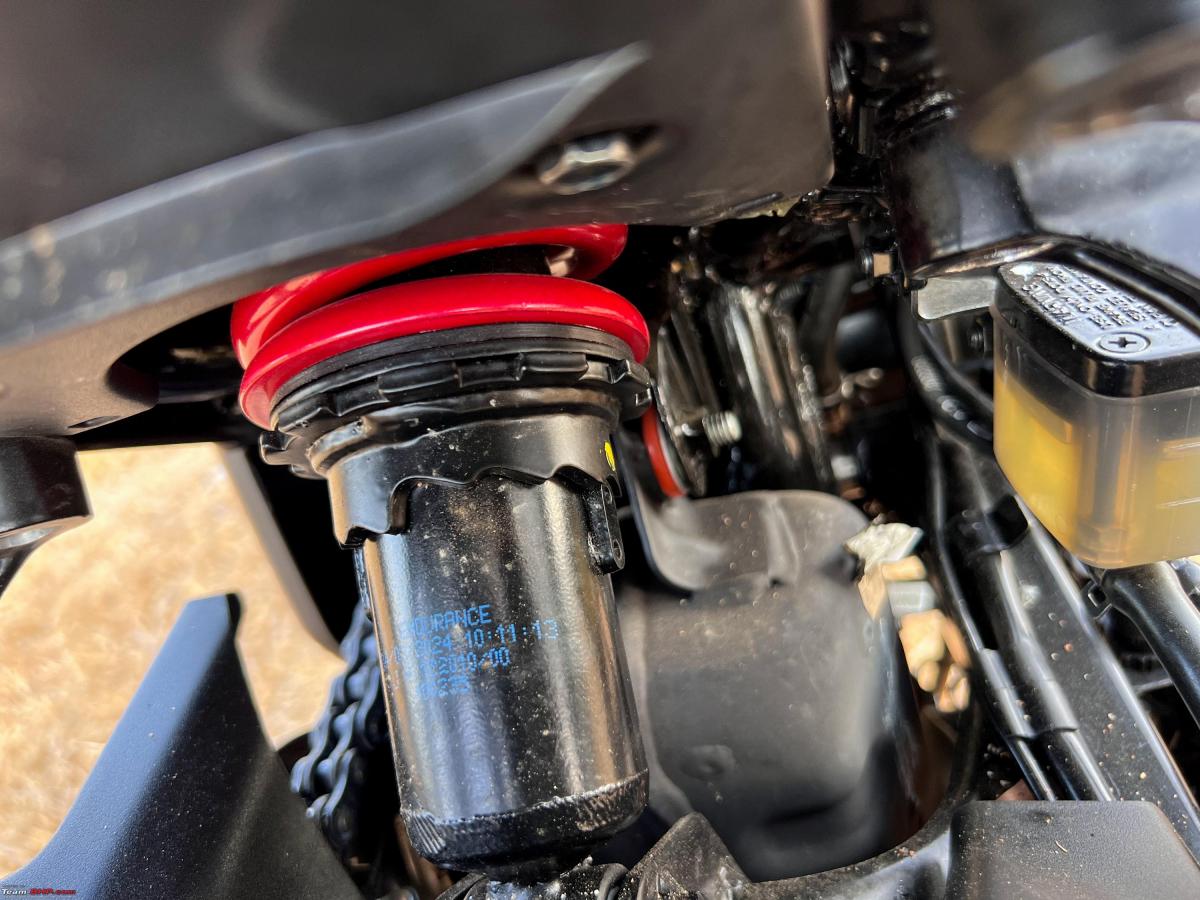
The N250's suspension duties are now handled by a 37 mm upside-down fork in the front and a monoshock, which is adjustable for preload at the rear. Both the front and rear suspensions are softly sprung, focussed towards providing a plush ride on city roads rather than outright cornering dynamics. In that regard, Bajaj has probably fallen short of making full use the newly introduced USD fork suspension for enhancing the dynamics.
That said, the suspension works very well in the urban concrete jungle, absorbing all the bumps with ease and ensuring riding comfort during commutes. On the highway, the bike does not feel as well planted and is, in fact, borderline nervous when pushed towards spirited riding territory. This is not to say the bike is not enjoyable. For the vast majority of the customer base of this motorcycle, highways and ghat sections are probably going to constitute a very small percentage of their usage. For city usage, the bike's suspension setup is executed very well and will keep owners happy.
The bike is heavier than its closest competitors, at ~164 kg (wet weight). At parking speeds or standstill, the extra weight is perceptible, but on the move, the bike feels sufficiently agile.
The ground clearance stands at a healthy 165 mm. This coupled with the short wheelbase means that the N250 should have no trouble clearing almost all speed-breakers, undulations and potholes on Indian roads, even the rural ones.
Braking
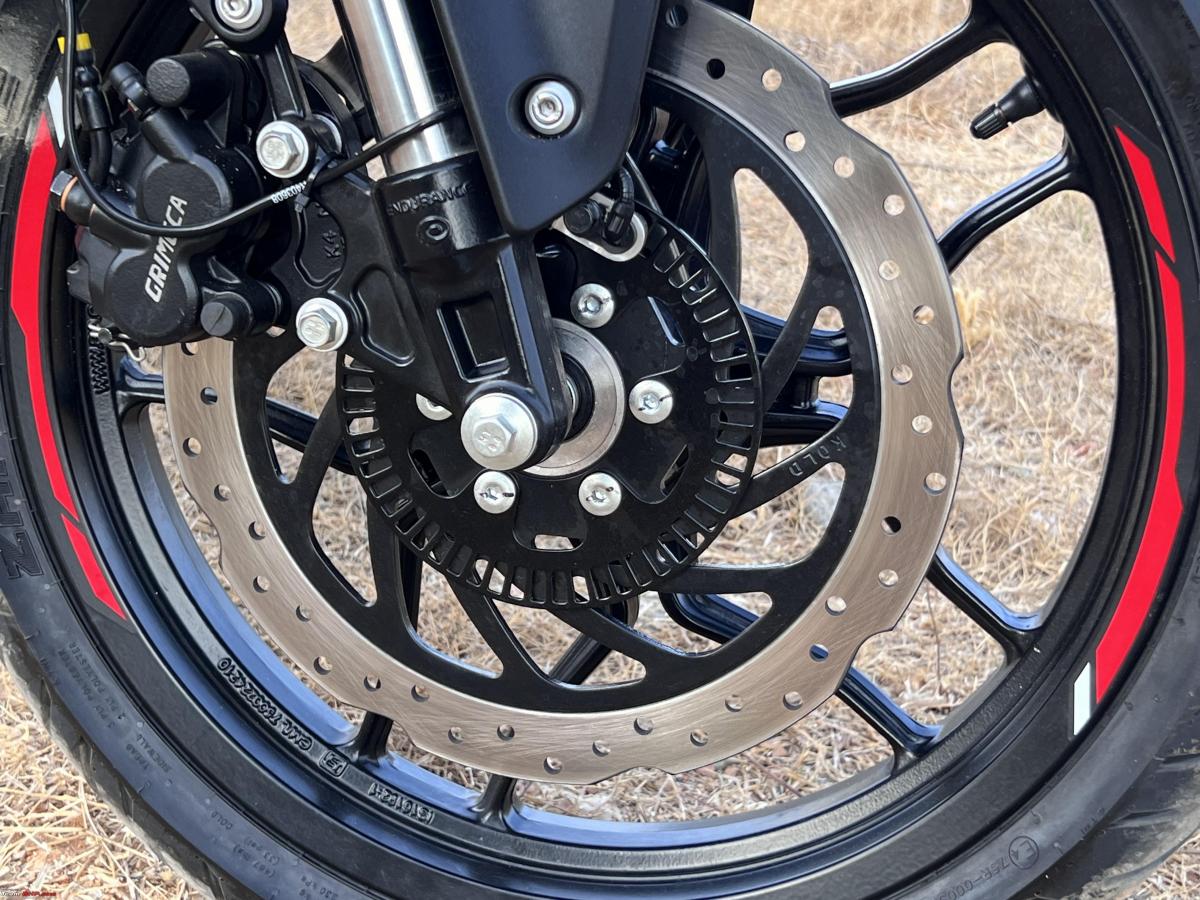
Braking is one of those aspects where Bajaj could have done a better job on the N250. At the front, the bike is equipped with a 300 mm disc brake, while the rear features a 230 mm disc. The N250 gets dual channel ABS with ABS ride modes to control the level of ABS intrusion based on the underlying terrain. The Grimeca branding is visible on the calipers and even the brake fluid reservoirs of the front and rear brakes.
The front brakes are okay for city commuting, but they lack sufficient bite force for spirited riding. The lack of feedback and a somewhat wooden feel take away the confidence of braking at higher speeds. The rear brake is very weak and next to useless - feels just like a footrest!
Closing Thoughts
Overall, the Pulsar N250 is a wonderful sport commuter package for the biker who wants a machine which can offer both practicality and fun. The N250 is happiest dealing with a mix of city and highway usage say in the ratio of 80-20. In urban confines the N250 shines with its mature and effortless riding experience, going about its duty happily while the owner attends to his/her errands and commutes. The refinement levels, practicality and tractable engine with the feather-light clutch and precise gear shifts offer a surprisingly high level of no-nonsense city riding pleasure. Ask this bike to step up to the job of highway trips, and it will do so gladly but with a few caveats such as the compromised dynamics, below-par braking and a lethargic power delivery at higher speeds.
Continue reading the discussion on the Bajaj Pulsar N250 on our forum.
- Tags:
- Indian
- Bajaj
- Bajaj Pulsar N250
- Review
News
Bajaj Pulsar N250 Review : 8 Pros & 7 Cons
The Pulsar N250 houses a fuel tank with a capacity of 14 litres which is decent. Coupled with a fuel efficiency of ~35-40 km/l depending on city and highway usage, one can expect an impressive tank range of around 500 km on a single tank of fuel.
Bajaj Pulsar N250 Pros
- Well-rounded, good-looking sporty commuter package packed with features and practicality
- Nicely priced. Undercuts most rivals in the segment
- Addresses almost all the weak points of its predecessor, while still retaining the solid fundamentals such as the engine and chassis characteristics
- Packed with features such as slip-and-assist clutch, upside-down fork suspension, digital instrument cluster, turn-by-turn navigation, LED projector headlight, switchable traction control, ABS modes, integrated USB charger, etc.
- Tractable engine with oodles of low-end torque coupled with good gearing and very light clutch makes riding effortless and adaptable to varied usage
- Refined engine with NVH levels rivaling Japanese 250cc commuters
- Deep and bassy exhaust note
- Mature suspension behaviour offers a nice balance between ride quality and handling
Bajaj Pulsar N250 Cons
- Front brake feels wooden and lacks progressive feedback. Rear brakes are devoid of any bite
- Some quirks in the ergonomics department, including placement of rear view mirrors, handlebar & side-stand lever
- Windblast and buffeting even at moderate speeds
- Sporty only within urban confines. Not very composed at highway speeds or during fast cornering
- 2-valve engine runs out of breath with climbing revs. Lack of sixth gear reduces the fun factor on highway rides
- Quality of plastics and decals, although better than before, has room for improvement
- Bajaj bikes are not known to age very well and it remains to be seen how long-lasting the refinement levels and plastic quality will prove to be over a few years of usage
Read Team-BHP's detailed Bajaj Pulsar N250 Review.
News
Review of A Square Car Detailing in Chennai: Why I highly recommend it
We decided to take a leap of faith and are happy to report that it paid off.
BHPian sterlingsilver recently shared this with other enthusiasts.
A close friend of mine was planning to detail his brand new, to-be-delivered car (PPF/Ceramic Coating etc) - a Hyundai Venue - when he reached out to me for advice and help.
Now, I usually detail my cars at The Detailing Mafia (TDM) in Anna Nagar. Vineet at this place (knowledgeable and friendly) gives the right suggestions and I have had good experiences with him all my cars have turned out well (an Elite i20, Innova, MG Hector and BMW 3 series).
While I am no expert, I usually know the right questions to ask and can articulate what I am looking for. When I suggested TDM to my friend, he wanted to explore a few other options before going with TDM. I was also interested as I was also keen to check out who is doing what these days.
My friend and I like to keep our cars as stock as possible. We like to live with what the OEM provides, and generally avoid accessories (freebies or otherwise). This time around, my friend picked up a brand new Hyundai Venue in Black - To stand out in the crowd and give a luxurious appeal - despite my heads-up on the difficulty of maintaining one.
My friend was particular that he wanted to protect the OE paint job of the car and keep it looking new for the next five years, at least! I told him that detailing is only half of the job and proper, regular cleaning and maintenance (right products, right methods) is vital for long-lasting results.
We decided to explore Ceramic Coating, Graphene Coating and PPF. We also wanted to explore "Clarity Coating" (Same Color) which is new in the market. However, I was sceptical since there were no takes yet on the results.
PPF: Considering the characteristics of a PPF, my friend was too tempted towards it. Unfortunately, the cost was beyond his budget, for the right quality and brand.
Ceramic Coating: My friend was confused with the fact that online reading materials for Ceramic Coating stated that it had no self-healing capabilities, but a few places were offering self-healing Ceramic products. Not wanting to take a chance, my friend decided to drop this also.
The only option remaining was Graphene Coating. So that's how it came to be!
Choice of Detailer:
My friend and I scouted around for quotes from vendors in Annanagar, ECR and OMR areas and were weighing on all the shortlisted ones.
One afternoon we happened to drive through Adyar for a client meeting when we noticed a new detailing place – ‘A Square Car Detailing (ACD)’. It was inside a shopping complex. We stepped in for a general inquiry and were greeted well by the ACD team.
The communication skills, body language etc., of the whole ACD team was very positive. Our team slowly and patiently listened to us and made us spell out our requirements.
We were asked which car was this for, the age of the car etc. We were given a full run-down on PPF, Ceramic, and Graphene and their pros and cons, properties, ageing factors, maintenance etc. They were clear and upfront with the info. Nowhere did the ACD team attempt to cross-sell any of their services.
We were explained that ACD uses Expel V and Saint Gobain materials and their quote for PPF for Hyundai Venue was approx Rs 1.8 Lakhs. One of ACD’s partners – Mr. Deepak also advised against spending too much money for a PPF stating “Why do you want to spend so much for a 17 lac MUV?”. Made sense. So we took the Graphene Coating, for which the quote was about Rs 50 thousand.
At this stage, we were comfortable with ACD but were unsure as ACD was opened only a few months ago. There were no Google customer reviews of ACD about Graphene Coating, but it had all round good reviews and feedback. ACD's Interior detailing and car wash services had 5-star reviews.
We decided to take a leap of faith and are happy to report that it paid off. The car was dropped off at ACD straight after taking delivery from the showroom.
From the time the car was dropped off, they continuously shared photos/videos of the stage-by-stage process on WhatsApp. We were happy to see the step-by-step process images/videos of the activities performed on the car with the rationale for why each step is essential. The whole process of Graphene coating took about 2.5 days, including the curing time.
Finally, on the day of delivery, my friend was super excited to see his car glittering and decked. He was shown the hydro-phobic effect across panels. He was also advised on how to check this and bring it back for correction if the hydrophobic effect weakens. We were given a detailed write-up on maintenance and a review scheduled within a week.
A quality place I would recommend - Knowledgeable and Sincere with a fair price tag.



Check out BHPian comments for more insights and information.
- Tags:
- Indian
- car detailing
- Review
News
Hyundai i20 Turbo DCT 25,000 km review: Good but could have been better
A 3-cylinder turbo-petrol mated to a dual-clutch transmission is not the best recipe for achieving good fuel efficiency in city traffic and this car is no exception.
BHPian Potenza recently shared this with other enthusiasts.
25,000 Km with the Hyundai i20 Turbo-DCT
It’s been more than three years since our i20 came home, a day before Dhanteras in 2020. During this time, it’s been our constant companion in Mumbai and Pune, been with us on some memorable holidays, frustrated us to the core with one big niggle, made our lives comfortable with its quiet cabin experience and entertained our drives with its lively engine. This is a review of our i20-1.0 T-GDi DCT Asta (O), all 25,000 km of it.
Design & Styling
Sensuous sportiness is what Hyundai calls the design language on which the i20 is based. Not sure about sensuous but yes it does look sporty and aggressive. The lines are sharp, the power bulge on the hood looks awesome and the headlamps and DRLs make the car look as if it means business. The distinctive tail lamps look great at night and there is no way you can mistake this car for something else. In profile the car looks extremely sporty, the piano-black elements on all four sides lending a touch of class to the design. The car looks well-proportioned and to my eyes, it looks fast even while standing still. The design is something that attracted us to this car and we really like the bold, in-your-face design.
What we don’t quite like is the unnecessarily heavy usage of chrome everywhere. I would have loved to have body-coloured door handles and a piano black door sill (a la the i20 N-Line) instead of chrome everywhere. And the chrome applique on the tail lamp spoils what is one great-looking tail lamp design.
There is minimal visual differentiation between the Turbo and Non-Turbo versions. A slightly different grille design which is noticeable only to the keen eye and just ONE turbo badge is not enough to offer to customers who have paid more. Yes, Hyundai had an N-Line in the pipeline but even then, how about a few more turbo badges at least?
Build Quality, Fit & Finish
Being a Hyundai, build quality was obviously not expected to be German-esq and it clearly isn’t. However, this particular generation of the i20 feels distinctly flimsier than the earlier ones. While there are no rattles and squeaks till date, the poor build is apparent while driving over Mumbai’s broken roads. The way the car thuds over potholes, ruts and lane markers is a clear giveaway of the poor build. Some panels also flex easily and the hatch in particular has taken the brunt of improper closing at malls. There are two distinct thumb-shaped depressions on the hatch, clearly made by too much pressure at the wrong place, and this clearly shows how thin the sheet metal on that part is.
Wheels and Tyres
The car is shod with 16-inch diamond cut alloys with 195/55 R16 CEAT SecuraDrive tyres. This is the first car in our family after my grandfather’s Ambassador to have CEATs (remember the ubiquitous CEAT Safety Drive?) and frankly, they are well below par. The tyre is clearly made for long life. The rubber is hard, the sidewalls are not supple and the tyre is generally uncomfortable and lacks grip. Another 10k Kms and I will get rid of them. The Alloys on the other hand look great and complement the edgy styling of the car.
Interiors
The car is extremely spacious, I am 5’10” and there is plenty of legroom at the back with the driver’s seat set for me. The rear seat is great on width too and will put many bigger cars to shame. 3-abreast rear seating was never a purchase criterion for us but for those who need it the rear seat is wide enough to accommodate three people in relative comfort. The i20 is also one of the rare hatchbacks which have a rear armrest. The armrest is positioned at a good height and serves its purpose. There is no cup-holder at the back, but in our car, the rear seat has rarely been used so it hardly matters. The seats are covered in smart-looking leatherette. The seats themselves are pretty comfortable and are fine for drives up to 3-4 hours. But the front seats lack any sort of lumbar support and this becomes a problem on long drives. We noticed it on a Goa-Pune drive when both our backs started hurting after around 6 hours of driving.
Internal storage is sufficient, our 1 Litre bottles fit perfectly in all the door trims and there is also a map pocket at the back of the passenger seat if anyone needs it. The front armrest is adjustable for length and the storage area underneath easily takes in my wallet, home keys and a small sanitiser bottle without any rattling noise. Sadly, one of the cup holders is occupied permanently by the air purifier which is a bit irritating. I would’ve preferred the extra cup holder to a purifier which should’ve had its own place.
In contrast to the external design, the interior design is pretty straightforward and timeless. The all-black dashboard looks contemporary and classy. The horizontal lines between the vents make the car feel wider than it is, the vents themselves are simple, easy to adjust and feel solid. The A/C controls thankfully are not touch-operated. All the A/C buttons and toggle switches for temperature and fan speed work with a positive click and can be operated without distracting the driver. The ambient lighting gives a nice blue hue to the interiors at night. The steering wheel is one of the nicer Hyundai wheels, it's small enough for my liking and the leather wrap feels good to hold. All the buttons fall to hand and it does its job well.
The digital instrument cluster looks good with everything being clearly displayed, although the purist in me will always prefer an analogue cluster. Vehicle speed and RPM are indicated by a numerical readout as well as moving bands on either side of the cluster. Honestly, I have never referred to the moving bands whilst driving and rely solely on the numeric readout. The readout for the revs is rather stupid. Who the hell refers to RPM in decimals? They could easily have deleted the decimal and left it at 12,20,25 etc with a “x100 rpm” sign. Hyundai has provided a temperature gauge as usual which I really like. I think this is one basic thing that should never be sacrificed at the altar of cost-cutting. While driving, the gauge always stays at the five-dot mark and usually takes around a Km to reach that stage.
The MID display shows the usual trip data with separate read-outs for accumulated trip information and current drive information. There is also an instantaneous fuel efficiency indicator with a horizontal bar showing the instantaneous consumption with the average F.E. shown in numbers. In Nav-mode, the MID shows data for the next turn including pictorial signs at places like flyovers, bridges etc. Pretty cool in this segment.
On the subject of the MID, a special mention of the Distance-to-empty (DTE) readout is a must. DTE is supposed to give you an approximate indication of the range that the car will travel with the available fuel. This reading should change with traffic conditions as it has done in all my previous cars. Essentially what this means is that the range should be calculated on the basis of driving conditions of the last 30/50 Km. However, Hyundai’s DTE seems to have only one formula to it. It only shows you the maximum possible distance that the car can travel at any given point in time. Due to this, the DTE readout is always highly optimistic and never accurate.
The MID also displays TPMS data for every wheel. The TPMS is temperamental, to say the least. While it’s a good feature to have, the readings vary widely depending on the time of day you’re driving and frankly I find it hard to believe that a reading of 33 psi in the morning can become 37 psi by afternoon. I understand that air expands etc. but to such an extent? I’ve had the TPMS light come on a couple of times when the air pressure in one of the tyres has reached 27psi. There was no puncture, it was another example of air pressure contracting depending on the time of day. While I always checked pressures in cold conditions for all our cars, I now make it a point to check pressures only late at night or very early in the morning.
A lot has been said about the quality of plastics in the car. In my opinion, the interiors definitely don’t look cheap. The dashboard plastics look very contemporary and go a long way in making the cabin look upmarket. Yes, the door trim plastics definitely could be better, but even they don’t look cheap. It's only when you touch it and feel the rough surface that you realise how hard it is. Frankly, it doesn’t bother either of us, and nobody who’s seen the car has commented on that.
What is definitely sub-par is the quality of the headlamp and wiper stalks. The headlamp stalk confounds me. The operation of the stalk is like premium cars i.e., shifting from low-beam to high-beam is seamless without a click. But the stalk itself is really sharp in certain places. It all looks good in the OFF position, but twist the switch and the sharp, rough inner edge peeks out. Same is the case with the wiper stalk.
The boot easily takes in weekend luggage for a family of four. One of the rare occasions when the rear seat was used was on a trip to Mahabaleshwar, and four cabin-sized strolly bags went in easily. The rear seat can be folded down if needed and comfortably takes in my bicycle with its front wheel removed.
Infotainment
The infotainment screen is large with a 10.25-inch display, the touch quality is excellent and responses are instant. But what stands out is the seamlessness of the system. The UX is absolutely slick, has never hung, and has generally worked perfectly till date. Both of us paired our phones to the system on Day 1 of purchase and it actually amazes me that we’ve never had to do the pair/unpair cycle even once after that. We also have a Gen 5 City CVT at home and compared to this system Honda’s DIGIPAD is trash. The i20’s system allows us to switch between phones very easily and that adds to the ease-of-use factor.
What I also like is the integration of the system with the MultiFunction Steering wheel. Once you set everything and start driving there is no need for the driver to touch the screen for anything. All the basic controls that are needed are present on the steering wheel. There is a separate button for answering calls and hanging up/rejecting. While driving with the A/C on in AUTO mode, the blower speed reduces automatically if you get a call and reverts to the original speed after you hang up. Very thoughtful. The system also updates pretty regularly. Given the condition of Vi’s network nowadays the updates do take a long time but they don’t hinder the functioning of the system in any way.
Neither of us are audiophiles and for us, the BOSE branded sound system is more than adequate for our usage.
The in-built navigation is obviously not up to Google Maps standard. With constant road construction going on in Bombay, old roads get closed to traffic and new ones are inaugurated on a regular basis. Updates for these changes take a long time to arrive and one is much better off using Google Maps in most situations. For E.g., the map update which showed the new Bandra East to BKC flyover came 3-4 months after the flyover was operational. On the plus side, the on-board Navi has very clear pictorial displays in situations like flyovers and bridges where it clearly shows you which road to take. Neat.
Air-Conditioning
The air-conditioner operates well and cools the cabin in no time. Even in situations when the car has been soaking up the sun, the A/C cools the car effectively and quickly. Our default setting is 23 degrees in AUTO mode which is perfect in most situations. For temperatures close to 40 degrees in bumper-to-bumper traffic, we have sometimes gone down to around 20 degrees but never below that. As I mentioned above fan speed is lowered automatically in AUTO mode whilst talking on the phone and goes back to the original speed after hanging up.
On the move
I like to sit as low as possible while driving and the driving position of the i20 is perfect for that. I don’t need to see the front left extremity of the car while driving and that allows me to sit with the seat at its lowest setting. The steering wheel is adjustable for rake and reach and helps in finding a good driving position quickly. The pedals are well placed and the armrest is at a comfortable height. The dead pedal could have been bigger, but I’m used to it now and doesn’t bother me anymore. The armrest is also wide enough for both of us to share it with our respective elbows. All round visibility is good and the IRVM is wide enough considering the size of the rear windscreen. The power window and mirror controls are well placed, but only the driver’s switch is backlit, which is a shame. At this price, Hyundai should have included UV-Cut glass all round. The level of tint on the windows and windscreens is not sufficient and lets in intense heat. The sunroof is something that both of us like, mainly because the light that comes in makes the car feel bright and airy. We’ve got dark sun film for the sunroof to keep the heat and a bit of light out.
Start the car when the engine is cold, and you’re greeted with a very rough-sounding three-pot motor. The sound is such that initially I felt that there was something wrong, but it quickly quietens down once warmed up. It takes a couple of days to get used to the cold start cacophony. The engine usually reaches its operating temperature in less than a Km in Mumbai weather and traffic.
City Driving
The light steering, excellent air-conditioning, comfortable seats and great driving position make city driving a breeze. You can hear a typical 3-cylinder thrum while driving around town at low speed (around 20-30 kph), but once you go slightly faster it fades away. What we really love is the sense of serenity that pervades the cabin. The NVH package filters outside noise very effectively and in combination with the super-effective A/C makes the cabin a quiet and calm place at all times.
Driving in Mumbai/Pune city, the performance is more than adequate, the slightly weak bottom-end results in a slowish initial response, but if you want to play traffic-light grand prix then the T-GDI is the engine to have amongst the range.
Hyundai’s DCT is not the most responsive around, but it’s still more than acceptable and while it hesitates a bit at standing starts, it quickly makes up for that momentary pause and accelerates to the needed speed briskly. On the move, the DCT engages gears smoothly and seamlessly, the way it is supposed to.
However, bumper-to-bumper traffic can sometimes confuse the DCT. Short acceleration and braking cycles make the gearbox fumble for gears and sometimes it cannot decide which gear is to be selected. This gets exacerbated if the road is slightly uphill/downhill. So sometimes you have situations where the gearbox downshifts/upshifts exactly when you want it to do the opposite and results in a jerky driving experience. This has more to do with it being a DCT than any defect and once you’re used to it, this behaviour becomes a bit easy to predict and handle.
Ride quality in the city is clearly below par. The car handles Mumbai/Pune city roads well without becoming uncomfortable, but the ride has a distinct harsh edge to it. The car has a tendency to crash into potholes at city speeds, which is partially due to the harsh ride and partially due to the hard Ceats.
Out on the highway
Our car is powered by Hyundai’s 1.0 T-GDi which makes 120 PS and 172 Nm. The engine belongs to the Kappa II engine family and is a 3-cylinder all-aluminium unit with a 12-valve DOHC head. The 3-pot Turbo-petrol is surprisingly smooth and sweet sounding even when revved hard.
Even with 120 PS and 172 Nm on tap, the performance of the 1.0 T-GDI is not what one can term as “explosive”. But, it’s fast. It propels the car to triple-digit speeds with a nonchalance that makes the car great fun to drive (more on this later) and long distances are covered effortlessly, without breaking into a sweat. While climbing ghats, slow lane-hogging trucks are dispatched with utmost ease and the car is at home on the highway, performing superbly as a long-distance mile-muncher. Drives to Goa, the Western Ghats etc feel like a piece of cake and I really love the effortless manner in which long distances are covered without the engine sounding strained in any situation.
However, there is a fly in the ointment. The car falls well short in the high-speed ride and handling department. Out on the highway, the i20 Turbo feels planted till around 120 Kph. But push a bit more and it feels loose, and light and doesn’t inspire any confidence to go faster. In terms of highway ride quality, the i20 rides well if the going is smooth and manages the odd bump, but hit a series of bumps and the car loses composure immediately and you quickly need to reduce speed.
Driving in ghats, the chassis gets overwhelmed with the speeds that the engine is capable of and gives up far before reaching the limits of the engine or the driver. As a result, you need to come off the throttle just as you start having fun. I’ve never driven a N-Line but clearly, this version is a bit of a contradiction with its excellent engine mated to a very poor chassis. The road to Mahabaleshwar is one of my favourite drives and in this car, I always reach Mahabaleshwar with the feeling of wanting more.
Braking is best described as adequate. It's sufficient to make the car come to a halt, but the brake pedal feels too soft and pressure modulation is difficult. There is also a minuscule delay between pressing the brake and the car starting to slow down. It’s easy to over-brake or under-brake and that is never a comfortable feeling.
All in all, this car’s weak chassis has forced Hyundai to compromise low-speed ride in order to achieve acceptable high-speed stability and ride quality. Clearly, this is a car that needs to be driven sensibly.
Fuel Efficiency
A 3-cylinder Turbo-Petrol mated to a DCT transmission is not the best recipe for achieving good fuel efficiency in city traffic, and the i20 Turbo is no exception. Pottering around Bandra, BKC, Kurla including the infamous Lal Bahadur Shastri (LBS) Marg the car returns between 8-9 kpl. Please note that this is in heavy rush-hour traffic with lots of idling with the A/C on.
On one particularly memorable evening, we took 2 hours to traverse the 11 km between Bandra West and Kurla West and the car returned 4.5 kpl. This was an exception though and I don’t hold it against the car. Just putting it out here to show the worst-case scenario.
But, trips to South-Mumbai where traffic is considerably less result in double-digit fuel efficiency and the car returns an excellent 11-13 kpl. This is of course aided by running on the Eastern Freeway or the sea link, and just goes to show how badly traffic affects turbo-petrols.
Out on the highway, with excellent power comes excellent fuel efficiency and the i20 Turbo redeems itself with fuel efficiency consistently between 17-20kpl. This includes trips to Goa, Mahabaleshwar, Koyna and numerous Mumbai-Pune runs.
BlueLink
Firstly, BlueLink is a must-have feature that works well most of the time.
Unlocking the car from the app is slightly slow, but locking happens much quicker. Starting the car remotely has been a boon on hot summer afternoons. The secret to getting it to work is to read the manual carefully and understand the conditions under which the remote start/stop/lock/unlock works. For e.g., the car will not start unless the handbrake is pulled to five clicks at least which is a necessary safety requirement. Once all the conditions are met and there is enough network strength available, the system works.
Yes, it does have its quirks, especially related to Vodafone’s poor network, but once you’re used to it it’s a great feature to have. The way I look at it is that I’d rather have it work 80% of the time than not have the feature at all.
My subscription has currently expired but will be renewing it soon.
Niggles
Two of them. The first one still keeps coming back. The rear hatch started rattling after around 2 months of usage. Hyundai replaced the latch under warranty. The first replacement worked for 6 months and again started rattling. They replaced it again with a modified part and worked fine till six months back. The latch was changed in warranty again in September'23 which made the problem go away. But it's February now and the irritating noise is back. I understand new cars have issues but this is a bit too irritating. It’s been more than three years now.
The second niggle exposed Hyundai’s apathy towards its customers. Around the same time of the rattling sound (Dec 2020), the car refused to unlock by pressing the request sensor. The switch was temperamental, it used to work at times and not work when it wanted. This happened randomly without any pattern. However, the request sensor on the hatch used to work without fail. Since only the door request sensor didn’t work and the one on the hatch always did, this problem was initially diagnosed as a problem with the door handle request sensor. The handle was ordered, the technician came home and replaced the handle, which worked for a few days.
A few days later the same problem struck. Another handle was ordered, and installed but the problem kept on repeating. Hyundai then advised the workshop to replace the Body-Control-Module (BCM), but Shreenath Hyundai’s Govandi workshop messed up the BCM programming and two days later they had to order a second BCM and the car was sent to the main workshop in Jogeshwari for proper programming and replacement.
Next evening Hyundai confirmed that the BCM replacement had happened correctly and the car was ready. I asked them not to send it in the evening since I like to check the car in daylight before taking delivery, so they sent it over the next morning. On the way, the inexperienced driver scratched the car in a few places, on the rear bumper, RH driver door and front bumper. Car was sent back to Shreenath and they sent back the car after a couple of days in the bodyshop. This was in March 2021.
June 2021, the problem struck again. I had lost patience by then and the sheer incompetence of Hyundai’s “National Customer Care Manager” was too much to handle. The gentleman in question emailed me to “assure me that they are taking care of the problem”. But two days later when I called him up to discuss something he asked me not to call him since their Mumbai team was already on the job and they were the ones who I should be speaking to and not him. In reply, I asked him if that was the case why did he send me an email in the first place? Just to reassure me? Infuriated by his nincompoopery, and mere lip-service by him and other members of Hyundai’s HO after-sales team I escalated the matter to Tarun Garg and only then did they take the issue seriously.
Long story short, the car was delivered to me in a week and it’s been working fine ever since. Sadly, they had to remove the entire dashboard to figure out the problem. Thankfully it doesn’t rattle in spite of the disassembly.
A word of praise for Hyundai’s After Sales Area Manager responsible for Shreenath at the time. He was the junior most person in the whole chain of command, but he was the most honest and straightforward of the lot. He honestly informed me of another scratch that happened while removing the dash and I allowed him to rectify it without going into details.
What the real problem was, I don’t know. They replaced the key set under warranty, but I don’t think that was the root cause. The problem was sorted and I didn’t bother to dig further. No compensation was asked for the trouble and none was offered.
Faults
Just one. In June/July last year, I had given the car to Kothari Hyundai Pune for some bodywork repair. While collecting the car from them post-denting-painting, the airbag light popped up. GDS diagnosed the culprit to be a defective Clock Spring. Since Kothari did not have the part in stock, I got it replaced under warranty from Shreenath’s Jogeshwari workshop. The part cost was Rs.11,850/-
Hyundai Service
I’ve spent Rs.17,433/- on routine service till date. No other costs have been incurred. That is basically 58 paise/Km (considering 30,000 service has been done) and that is amongst the cheapest maintenance costs that I’ve incurred in all these years of car ownership, way cheaper than even Maruti.
On the flip side, I think Shreenath Hyundai’s Govandi service center is ok, nothing to write home about. I carried out the second service at Arsh Hyundai Chembur and the service was pretty similar. The advantage with Arsh is their service center is located in a far better place as well as the infrastructure at the workshop is way better than Shreenath Govandi. Neither of these workshops has pleased me enough to go there regularly. Shreenath’s Jogeshwari workshop is better than their Govandi one, more organised and located in a better area.
Next time, I plan to service the car in Pune, in my experience with other brands Pune workshops offer a much better personal touch than Mumbai ones.
Conclusion
After 25,000 Km and 39 months, our experience with the i20 Turbo DCT has been good, but it could have been much better without the niggles and Hyundai HQ's poor response.
Having said that there are some clear positives as well. The design is superb to look at. The in-cabin experience, performance, space, air-conditioning, extensive feature-list, all combine to make every drive comfortable and hassle-free. Whether it is a drive in the city or on a long journey, the car is never a topic of concern and that is always a good thing. That really shows the easy-going hassle-free nature of the i20.
We particularly love the absolute calm of the cabin irrespective of traffic conditions. No, this is no hot hatch and we are fine with it. The effortless performance that the 1.0 T-GDi delivers can be easily enjoyed if driven sensibly.
The way to enjoy the i20 is to drive within its performance envelope. Do that and you realise that the car punches well above its weight in most other areas.
Hope you enjoyed reading this review. Thank you!
Check out BHPian comments for more insights and information.
News
Volvo XC40 Recharge SM : Observations after a day of driving
Like most European cars, in a straight line, the XC40 Recharge feels very stable. It’s so planted that you won’t realise how fast you are going.
Driving the XC40 Recharge Single Motor

The XC40 Recharge Single Motor comes with a 69 kWh lithium-ion battery pack mounted on the floor of the car. Powering the car is a single electric motor that puts out 235 BHP and 420 Nm. It comes with a shift-by-wire single-speed transmission and rear-wheel drive configuration.
The first thing you notice when you want to start the car is that there is no start/stop button. To bring the electric motors to life, you need to press the brake and put the gear shifter in “D” mode. There is a sensor that detects if someone is present in the driver’s seat. Only then does the car’s motor start.
Step on the accelerator and the car moves forward gently. There are no jerks from gearshifts and no sound from the engine, which means it is an extremely refined experience. What’s great is that the car comes with a one-pedal drive feature which can be activated through the touchscreen head-unit. This allows the XC40 Recharge to be driven by just using the accelerator and without using the brakes in bumper-to-bumper traffic. Driving the car in city traffic is a breeze. While the front visibility is good, and side visibility is average. However, the thick C-pillars hamper the visibility through the rear windshield.
On the open road, the XC40 Recharge provides instant acceleration when you step on the accelerator. Volvo claims a 0-100 km/h sprint time of 7.3 seconds, which though 2.4 seconds slower than the dual motor version, is still quite fast. Floor the A-pedal and you will surge ahead of most other cars around you. It provides enough excitement to keep enthusiasts happy.
The XC40 Recharge can easily cruise at triple-digit speeds on the highway and when you need to overtake a slower vehicle quickly, just floor the A-pedal and fly past the vehicle. However, the harder you drive, the faster the range drops. This is also why you will see EVs that are driving longer distances sticking to the middle lane and cruising at 80-100 km/h (which is the best cruising speed for the current lots of EVs).
Off-road Mode
The car comes with an Off-road drive mode that can be activated through the touchscreen. It is only available at slow speeds. It provides enhanced traction which makes it possible to increase or reduce the speed of the car on steep hills by using only the accelerator pedal, without using the foot brake.
Regenerative Braking
Unlike many other EVs, the XC40 Recharge does not get adjustable regenerative braking. Instead, as mentioned earlier, it comes with a one-pedal drive feature. The car will start shedding speed the moment you lift your foot off the accelerator and come to a stop. It is beautifully calibrated and a boon in city traffic. Engine-braking lovers will appreciate driving with this feature activated.
One can switch the one-pedal drive feature off through the touchscreen. However, this will mean absolutely no regeneration. There is an "Auto" mode as well in which the system decides when to activate the one-pedal drive. With one-pedal driving engaged, the car loses speed rapidly when the accelerator is released. Therefore, at highway speeds, it's best to deactivate the feature or use Auto mode where the car won't immediately decelerate. If the one-pedal drive feature is switched on at highway speeds, the regen is strong and vehicles behind you might end up coming very close to your car. Volvo should've just provided adjustable regeneration as it gives the driver control as per his / her comfort level.
Noise, Vibration & Harshness (NVH)
Like most EVs, the XC40 Recharge is super quiet. There’s no engine or gearbox to make any noise, so the overall driving experience is silent. At slow speeds, no one will hear you coming and you might need to use the horn to warn others of your presence.
Cabin insulation is top class and wind noise and tyre / road noise are well controlled. Overall, the cabin is a quiet and comfortable place to be in.
Range
The Volvo XC40 Recharge Single Motor has an ICAT-certified range of 592 km or a WLTP-certified range of 475 km. I drove the car for ~150 km and used up ~40% of the battery. So in real-world driving conditions, you can expect a range of ~350 km. Given the rising demand for EVs, there are plenty of charging stations popping up everywhere, which ought to take care of range anxiety as well.
Charging
Volvo provides an 11 kW charger as standard with the XC40 Recharge. A full charge should take ~8 hours. The car can also be charged using a 150 kW fast charger. The company claims that this can charge the battery from 10% to 80% in ~30 minutes.
Suspension
Ride Comfort
The Volvo XC40 Recharge gets a MacPherson strut suspension at the front and a multi-link suspension at the rear. The suspension is on the stiffer side and the car rides on 19-inch wheels. This makes the low-speed ride firm. Every crack and bump on the road is felt. While the ride is not uncomfortable, it is far from plush. As we have seen in the case with most stiff suspension setups, the ride quality improves with speed. The recommended tyre pressure is a rather high 41 PSI. Dropping the pressure might help improve the ride.
Handling & Dynamics
Like most European cars, in a straight line, the XC40 Recharge feels very stable. It’s so planted that you won’t realise how fast you are going. Undulations on the road are dispatched with aplomb. In the corners, body roll is very well-controlled and the car handles admirably when driven hard through a series of corners. Mid-corner bumps are easily dealt with and the car doesn't lose its composure. The stiff suspension helps matters when the car is driven hard. The Pirelli tyres provide excellent grip as well.
Steering
The electric power steering is a nice unit and easy to operate as well. It is light at city speeds which makes it very user-friendly. The steering weighs up well at highway speeds. Further, it can be given some more weight by activating a mode through the touchscreen. Overall, the steering feels connected and inspires confidence.
Braking
Volvo has equipped the XC40 Recharge with 18-inch discs at the front and rear. These give the car great stopping power. I slammed on the brakes when the car was doing ~120 km/h and the car stopped without any drama.
Continue reading the discussion on the Volvo XC40 Recharge Single Motor on our forum.
Pages





